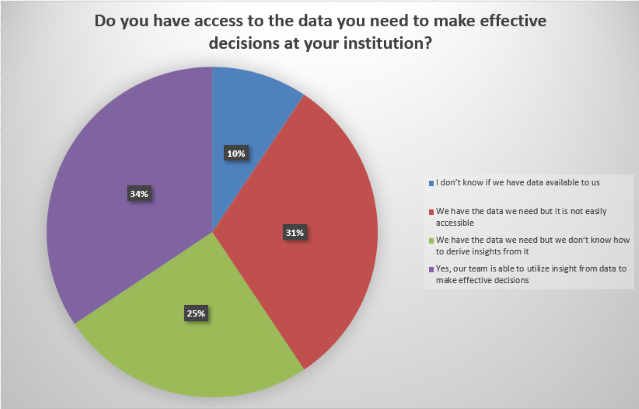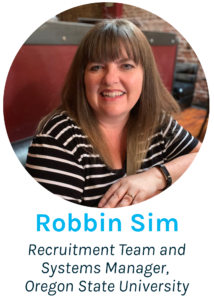Data Analytics and Insights: Fueling a Better Future for HigherEd
Embracing data analytics and insights can be intimidating, but it’s also necessary for institutions to engage with their data to keep up in a data-driven world. Actionable insights are vital to inform strategic decision-making, identify problems, and enact positive change. In a poll during our recent webinar, attendees were asked: Do you have access to the data you need to make effective decisions at your institution? 10% of respondents said that they didn’t know if they had they data they need, and 25% said that they have data but don’t know how to derive insights from it.
Luckily, there are tools to help institutions tackle these challenges, and launching an analytics strategy is more accessible than you think. Whether you’re just getting started with analytics or are craving even more insights, check out a few key takeaways from our Data Analytics webinar below.
Data vs. analytics vs. insights
Monte Morast, PeopleAdmin’s Associate Director of Software Engineering, explained the nuances between data, analytics, and insights—terms which are sometimes used interchangeably but mean different things.
 As Monte noted, data is raw facts and numbers. But numbers alone are hard to understand, contextualize, and extract meaning from. That’s where analytics come in. Analytic tools and processes help you establish connections, view, and consolidate data in a way that spreadsheets don’t allow. When you take those analytics tools and use them to see correlations between data, that’s where you get insights. Data alone can’t fuel strategic decision-making, but insights—like time-to-fill in each department, or workload balance broken down by gender—can help you identify problems and offer a path to solving them.
As Monte noted, data is raw facts and numbers. But numbers alone are hard to understand, contextualize, and extract meaning from. That’s where analytics come in. Analytic tools and processes help you establish connections, view, and consolidate data in a way that spreadsheets don’t allow. When you take those analytics tools and use them to see correlations between data, that’s where you get insights. Data alone can’t fuel strategic decision-making, but insights—like time-to-fill in each department, or workload balance broken down by gender—can help you identify problems and offer a path to solving them.
What can analytic tools measure across my institution?
Monte shared some insider tips about the types of information that your institution can measure in different departments with PeopleAdmin’s Insights.
For Human Resources teams, PeopleAdmin’s analytic tools can help measure effectiveness in areas including time-to-fill, time-to-hire, and retention. The tools can measure DEI metrics by department, role type, or time period, and help identify potential areas of improvement. Your team can also examine budgets across campus, supporting strategic planning and anticipating needs.
For faculty and academic affairs teams, our tools help analyze faculty workload and activity reports, and examine whether all staff or faculty are being effectively utilized.
Analytics at your institution
 Robbin Sim, Recruitment Team and Systems Manager at Oregon State University, shared some real-life examples of the benefits of Unified Insights. One notable benefit was that, by examining workload, output, and staffing across the institution, Robbin has identified a need for more full-time employees to fulfill the needs of the institution and its customers. Thanks to the reports she can compile in Unified Insights, she can defend this need to administrative leaders—everything is backed up by relevant data.
Robbin Sim, Recruitment Team and Systems Manager at Oregon State University, shared some real-life examples of the benefits of Unified Insights. One notable benefit was that, by examining workload, output, and staffing across the institution, Robbin has identified a need for more full-time employees to fulfill the needs of the institution and its customers. Thanks to the reports she can compile in Unified Insights, she can defend this need to administrative leaders—everything is backed up by relevant data.
Robbin also noted that she has been better able to support the needs of departments across campus. Reports on different functions—like hiring metrics or application reports—help other departments better understand where there are roadblocks in their hiring processes, or where to focus their efforts if they are hoping to increase diversity in their staff.
Tips to get started
Even if you’ve never worked with data or analytic tools before, your institution likely already has more useful information than you think, sometimes stored in disparate systems all across campus. The right analytics tools can help you unlock and make sense of all that information. But before you get started with embracing data analytics, it’s essential to examine your needs and define your goals. If your team or institution doesn’t know what they’re looking for, it’s difficult to effectively utilize your analytic tools.
Communication is also vital, according to Monte. Break down technology silos across campus to compare data from disparate systems, and encourage all stakeholders to understand the capabilities and outputs of the analytic tools on campus.
It’s time to dive in
One final tip from our insider experts: don’t be afraid to get in the weeds when its time to start embracing data analytics. The data is there and the insights are there. Dig around! It can’t hurt to start looking.
To learn more about the capabilities of PeopleAdmin’s Insights, check out our webinar on demand or reach out to our experts.
